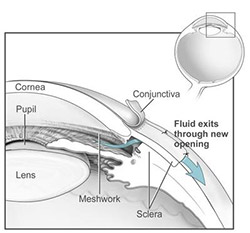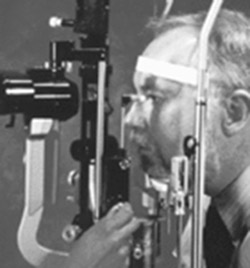Glaucoma
Glaucoma is a group of diseases that can damage the eye's optic nerve and result in vision loss and blindness. While glaucoma can strike anyone, the risk is much greater for people over 60.
There are several different types of glaucoma. Most of these involve the drainage system within the eye. At the front of the eye there is a small space called the anterior chamber. A clear fluid flows through this chamber and bathes and nourishes the nearby tissues.
Causes

In glaucoma, for still unknown reasons, the fluid drains too slowly out of the eye. As the fluid builds up, the pressure inside the eye rises. Unless this pressure is controlled, it may cause damage to the optic nerve and other parts of the eye and result in loss of vision.
The most common type of glaucoma is called open-angle glaucoma. In the normal eye, the clear fluid leaves the anterior chamber at the open angle where the cornea and iris meet. When fluid reaches the angle, it flows through a spongy meshwork, like a drain, and leaves the eye.
Sometimes, when the fluid reaches the angle, it passes too slowly through the meshwork drain, causing the pressure inside the eye to build. If the pressure damages the optic nerve, open-angle glaucoma -- and vision loss -- may result.
There is no cure for glaucoma. Vision lost from the disease cannot be restored. However, there are treatments that may save remaining vision. That is why early diagnosis is important.
Risk Factors
Nearly 3 million people have glaucoma, a leading cause of blindness in the United States. Although anyone can get glaucoma, some people are at higher risk. They include
- Everyone over age 60
- People with a family history of glaucoma.
Symptoms and Diagnosis
Glaucoma can develop in one or both eyes. The most common type of glaucoma, open-angle glaucoma, has no symptoms at first. It causes no pain, and vision seems normal.
Without treatment, people with glaucoma will slowly lose their peripheral, or side vision. They seem to be looking through a tunnel. Over time, straight-ahead vision may decrease until no vision remains.
Glaucoma is detected through a comprehensive eye exam that includes a visual acuity test, visual field test, dilated eye exam, tonometry, and pachymetry.
A visual acuity test uses an eye chart test to measure how well you see at various distances.
A visual field test measures your side or peripheral vision. It helps your eye care professional tell if you have lost side vision, a sign of glaucoma.
In a dilated eye exam, drops are placed in your eyes to widen, or dilate, the pupils. Your eye care professional uses a special magnifying lens to examine your retina and optic nerve for signs of damage and other eye problems. After the exam, your close-up vision may remain blurred for several hours.
In tonometry, an instrument measures the pressure inside the eye. Numbing drops may be applied to your eye for this test.
With pachymetry, a numbing drop is applied to your eye. Your eye care professional uses an ultrasonic wave instrument to measure the thickness of your cornea.
Treatment
Although open-angle glaucoma cannot be cured, it can usually be controlled. While treatments may save remaining vision, they do not improve sight already lost from glaucoma.
The most common treatments for glaucoma are medication and surgery.
For most people with glaucoma, regular use of medications will control the increased fluid pressure. But, these drugs may stop working overtime. Or, they may cause side effects. If a problem occurs, the eye care professional may select other drugs, change the dose, or suggest other ways to deal with the problem.
Laser surgery is another treatment for glaucoma. During laser surgery, a strong beam of light is focused on the part of the anterior chamber where the fluid leaves the eye. This results in a series of small changes that makes it easier for fluid to exit the eye. Over time, the effect of laser surgery may wear off. Patients who have this form of surgery may need to keep taking glaucoma drugs.
FAQ's - Frequently Asked Questions
What is glaucoma?
Glaucoma is a group of diseases that can damage the eye's optic nerve and result in vision loss and blindness. The most common form of the disease is open-angle glaucoma. With early treatment, you can often protect your eyes against serious vision loss.
What is the optic nerve?
The optic nerve is a bundle of more than 1 million nerve fibers. It connects the retina to the brain.
What is open-angle glaucoma?
Open-angle glaucoma is the most common form of glaucoma. In the normal eye, the clear fluid leaves the anterior chamber at the open angle where the cornea and iris meet. When the fluid reaches the angle, it flows through a spongy meshwork, like a drain, and leaves the eye.
Sometimes, when the fluid reaches the angle, it passes too slowly through the meshwork drain, causing the pressure inside the eye to build. If the pressure damages the optic nerve, open-angle glaucoma -- and vision loss -- may result.
Does increased eye pressure mean that I have glaucoma?
Not necessarily. Increased eye pressure means you are at risk for glaucoma but does not mean you have the disease. A person has glaucoma only if the optic nerve is damaged. If you have increased eye pressure but no damage to the optic nerve, you do not have glaucoma. However, you are at risk. Follow the advice of your eye care professional.
Will I develop glaucoma if I have increased eye pressure?
Not necessarily. Not every person with increased eye pressure will develop glaucoma. Some people can tolerate higher eye pressure better than others. Also, a certain level of eye pressure may be high for one person but normal for another.
Can I develop glaucoma without an increase in my eye pressure?
Yes. Glaucoma can develop without increased eye pressure. This form of glaucoma is called low-tension or normal-tension glaucoma. It is not as common as open-angle glaucoma.
Who is at risk for open-angle glaucoma?
Anyone can develop glaucoma. Some people are at higher risk than others. They include
- African-Americans over age 40
- everyone over age 60, especially Mexican-Americans
- people with a family history of glaucoma.
How can I prevent the disease from occurring?
At this time, we do not know how to prevent glaucoma. However, studies have shown that the early detection and treatment of glaucoma, before it causes major vision loss, is the best way to control the disease. So, if you fall into one of the high-risk groups for the disease, make sure to have your eyes examined through dilated pupils every two years by an eye care professional.
What are the symptoms of glaucoma?

At first, open-angle glaucoma has no symptoms. It causes no pain. Vision seems normal. (Answer continues on next page.)
Without treatment, people with glaucoma will slowly lose their peripheral, or side vision. They seem to be looking through a tunnel. Over time, straight-ahead vision may decrease until no vision remains.
How is glaucoma detected?
Glaucoma is detected through a comprehensive eye exam that includes a visual acuity test, visual field test, dilated eye exam, tonometry, and pachymetry.
Can glaucoma be cured?
No. There is no cure for glaucoma. Vision lost from the disease cannot be restored.
Can glaucoma be treated?
Yes. Immediate treatment for early stage, open-angle glaucoma can delay progression of the disease. That's why early diagnosis is very important. Glaucoma treatments include medicines, laser surgery, conventional surgery, or a combination of any of these. While these treatments may save remaining vision, they do not improve sight already lost from glaucoma.
What can I do to protect my vision?
If you are taking medicines for glaucoma, be sure to take them every day as directed by your eye care professional. People at risk for glaucoma should have a dilated eye exam at least every two years. If you have been diagnosed, you may need to see your eye care professional more often.
What can I do if I already have lost some vision from glaucoma?
If you have lost some sight from glaucoma, ask your eye care professional about low vision services and devices that may help you make the most of your remaining vision.
Ask for a referral to a specialist in low vision. Many community organizations and agencies offer information about low vision counselling, training, and other special services for people with visual impairments. A nearby school of medicine or optometry may provide low vision services.
What should I do for a family member or friend who may be at risk of glaucoma?
Encourage them to have a comprehensive dilated eye exam at least once every two years. Remember -- lowering eye pressure in glaucoma's early stages slows progression of the disease and helps save vision.
Does Medicare cover the cost of an annual comprehensive eye exam?
Yes, in certain cases. Medicare covers an annual comprehensive dilated eye exam for some people at high risk for glaucoma. These people include those with diabetes, those with a family history of glaucoma.
You will need the Adobe Reader to view and print these documents.
![]()









